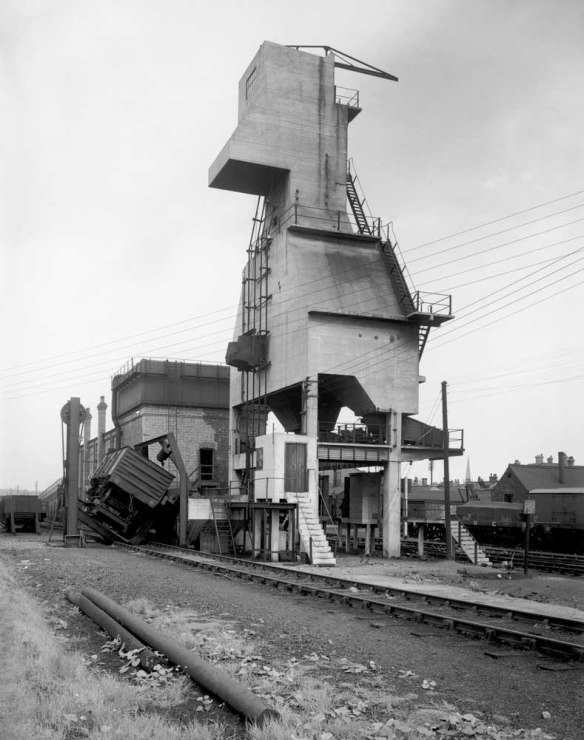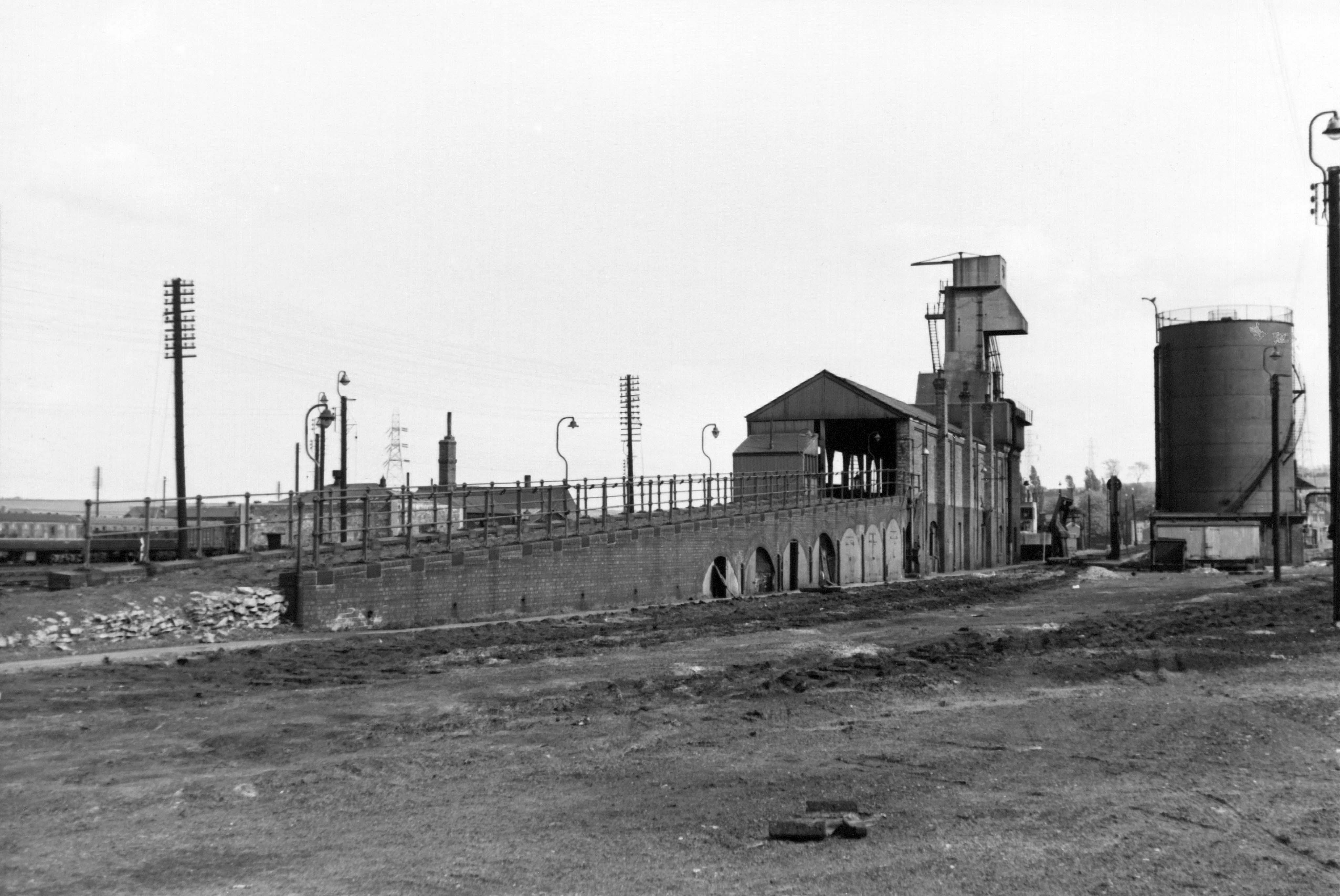By Roy Vinter
On arrival on shed fires were often cleaned before visiting the coaling plant if waiting in a queue, which was frequent. If the engine was fitted with rocking grates and hopper ashpans (e.g. A1s etc.) the ash may be dropped as well, though I'm not sure if there was a pit there. We often filled up with water along the side of the old coal stage where there were two water cranes.
Two ashpit roads, after the coaling plant, were where disposal really took place. These would each accommodate three or four tender engines. Yes, I remember those days well at Grantham, cleaning fires on ‘tangos' - hard work indeed. It meant going underneath in the pit to rake out and swill out the ashpan with hoses on the pit walls, sometimes clambering over heaps of hot ashes, I may add. The ash was all shovelled out of the pits to ground level, and then again into a wagon.

Photograph taken by Noel Ingram.
The coal at Grantham was all top grade stuff, and the same in both hoppers of the coaling plant, not as some depots apparently did, having two grades, one for express work and the other for goods work. This I was informed of by Ken Willetts, who remembers that locomotive coal arrived at Grantham from Yorkshire collieries including Harworth, Rossington, Maltby, Brodsworth and Denaby.
I’m not sure how often we had coal delivered. Possibly once a week, but may be wrong. 9.00am was the ‘coal shunt’ job, but whether it was every day I don't know. The shunter was Wally Simmons, and stores vans would be sorted as well as sludge carriers (from the water softener). These were, incidentally, taken to Ranskill where the sludge was dumped.
Loaded wagons of coal were pushed from the north end over the coaling plant tippler platform and up the bank. The platform couldn’t carry a locomotive’s weight - ‘Engines Not Allowed’ the notice said - so barrier wagons were used in front of the shunt loco. The coaling plant operator would pin all the wagon brakes down and then, as required, let them roll downhill one at a time onto the tipping platform, with shunting pole as a lever on the brake handle. The Grantham plant had a hopper below ground level, where the wagon tipped its load. The hopper loaded a skip, which was then hoisted up and tipped into the main hopper at the top (I don't think any two coaling plants were alike). The coaling plant operator, a gent called Ron Kent in my day, had a concrete hut from where he controlled the operation.

London & North Eastern Railway (LNER) official photograph.

Photograph lent by Ken Willetts.
When the big tower was out of action locos were coaled by a crane with a grab.
I don't ever remember the old coal stage being used in my time. The floor of the coaling area was laid with large-sized steel plates, which would help with wheeling the coal skips around on their big metal wheels. The wheels were designed to fit in the curve of the tilting flap gadgets at the two loading points, which had some hefty counterweights to tip them back after emptying the coal into the loco tenders.
At the north end of the working floor of the coal stage there was a cabin for the coal skip operators. I'm sure there was a stove and obligatory kettle in there, though I never saw it in use in my time. It was built of wood and was supported by a substantial wooden cantilever type structure built into the end wall of the coal stage beside the ramp up to the stage (the ramp being narrower than the full width of the stage). There was a window in the east side of the cabin, overlooking the coaling road. In the south side, looking into the coaling area, there was a window nearest the east side, and a part-glazed door adjacent to it.

Photograph lent by Ken Willetts.

Photograph lent by Ken Willetts.
Under the coal stage at the Loco were stores and mess rooms. Going north from the water tower at ground level on the west side, the first opening was the stores, which extended back under the water tank. From the stores one could obtain such things as oil and swab (paraffin?) and rags for cleaning; oil and oil feeders for loco preparation, lamps etc. White cloths were a standard daily issue to enginemen, in return for a dirty one which would be washed and then known as a ‘first wash cloth’, after which they were used for cleaning. The stores extended back under the water tank where clothing, caps and all sorts of things were kept.
The next door was the cleaners’ mess room, a right muck hole (to keep things polite!) with a large open fire in it. Next was the drivers’ and firemen's mess room. This occupied two of the arches under the old coaling stage, with a connecting door into a locker room with a couple of washhand basins, all kept somewhat more civilised.
Further north beneath the ramp were several arches, declining in headroom as the ramp descended, which were kept locked. They contained new fire irons for one thing, but I’m not sure what else.

Photograph lent by Ken Willetts.
Alongside the east side of the top shed there was a long pile of coal on the ground running parallel with the two roads alongside the shed. These two roads were known as ‘Coronation’, and were generally used to store engines awaiting work or repairs. I remember once coaling by grab crane taking place there.
The two loops near the exit from the Loco, where prepared engines were placed, was London Road. There was a phone there to the North Box to tell the ‘bobby’ when you were ready to leave the shed. There were three miniature signals to exit the Loco, arranged vertically on one post. They read ‘top to the left’. Bottom was to down main (seldom used, I think); middle to Nottingham line; top, I think, to the engineers’ sidings to the west of the Nottingham line - though I would stand corrected on this. To get to the engine spur at the north end you would reverse into it from the Nottingham line.

Photograph by Roger Hateley.
This image is from the collection of The Railway Correspondence and Travel Society (RCTS) ref. RH01802 and is used here with permission.
Entry to the Loco was always from the North Box end. It was possible to move between the Loco and the down goods yard using a connection just about on a level with the cenotaph coaling plant, but this was extremely rarely used and only in an emergency. I can remember it used once in my spell as time office runner, when a young cleaner. The foreman, Fred Blanchard, was watching very closely (as I was) as an A3 creaked along the rusty rails to get out of the Loco. There must have been something wrong up the north end I suppose.
At the back of the old shed (i.e. the south end), and attached to it, was the fitters’ shop and the general office/shedmaster’s office, all in the same brickwork. These two offices were quite small really, considering their importance.
The time office (Loco. Dept.) was a wooden building, quite long as it also accommodated small offices for the CME/engine examiner (Frank Lawrance at that time) and one or two others including the roster clerk and the two running shed shift foremen, one ‘inside - in the chair’, as he was known, and one supposed to be running things outside. There was also a signing-on time clerk and time office runner. All the links, rosters and daily/weekly roster alterations were posted in there, as well as daily notices of temporary line works, speed restrictions etc. It was really the hub of activity for the day to day running of the depot.

The photograph was taken in mid-1963 by fellow fireman Fred Harris who, Roy says, had 'a posh camera' which took better pictures than the normal snaps of the time.
Photograph lent by Roy Vinter.
Copyright note: the article above is published with the appropriate permissions. For information about copyright of the content of Tracks through Grantham please read our Copyright page.


I have read most of these memories before on the LNER site but have really enjoyed reading them once again. As an outright trainspotter much of what was happening at the Loco was a real mystery to me -- now I know.
Thanks Richard, glad you enjoyed my scribblings and you're a little more enlightened on loco activities.
Roy.
Would you have worked with my dad Jack Woodward ?
Hello Paul - thanks for your query. Was your Dad at Grantham Loco too then? We'll forward this to Roy and ask if he remembers Jack.
Hello Paul,
I'm sorry but I can't recall your dad, Jack. I was at Grantham from Aug.'57 to Dec.'63. Was your dad there during that time? Was he in the loco. dept. ?
Roy.
A riveting read. My grandfather was a Driver at New England and unfortunately I did not get chance to talk about his experiences before he passed away. This record is of great historic and social importance. Hopefully a lot of our relatives will record their working memories.
Hello Kevin,
Thank you. We're sure the many people who are contributing to these pages will be pleased to hear that you've enjoyed their contributions to this expanding and fascinating story of a town and its railway community. It's kind of you to recognise the value of our project. Please keep coming back. If you haven't already done so you can 'subscribe' and receive an email every time something new is added. More about this here.
John Clayson
Thankyou Kevin, I'm glad you enjoyed my tales. It's nice to feel appreciated.
Roy.
Better described than any book I've read, thank you for taking the time to explain the way it was.
Thanks Allan , I appreciate your comments .
Roy.